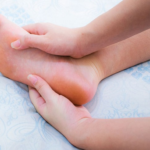Many people spend hours sitting at desks, in front of computers, or commuting in cars, and they don’t even realize how much it’s affecting their back. If you’ve ever ended your workday with a stiff back or sore shoulders, you’re not alone. Sitting for long periods can cause or worsen back pain, especially if you’re not sitting correctly.
In this article, we’ll explain how sitting affects your back, and share practical, easy-to-follow tips to help you prevent back pain — whether you work at home or in an office.
Why Does Sitting Cause Back Pain?
Your body is designed for movement. When you sit for long hours, your muscles get tight, your joints stiffen, and your circulation slows down. Over time, poor posture, weak core muscles, and a bad chair can all lead to pain in your lower back, shoulders, and even neck.
Sitting compresses your spine, especially your lower back (lumbar spine). This compression reduces the space between your vertebrae, which can irritate nerves and strain muscles. It also weakens the muscles that support your spine, like your abs and glutes.
Simple and Effective Tips to Prevent Back Pain from Sitting
1. Set Up an Ergonomic Workspace
Start with your environment. Your desk, chair, and computer setup play a huge role in your comfort.
- Chair: Use a chair with good lumbar (lower back) support. The backrest should support the natural curve of your spine.
- Feet Position: Keep your feet flat on the floor or on a footrest. Avoid crossing your legs.
- Desk Height: Your elbows should form a 90-degree angle when typing.
- Monitor Level: Your screen should be at eye level so you don’t have to tilt your head up or down.
2. Sit with Good Posture
Even with the best chair, your posture matters.
- Keep your back straight and shoulders relaxed.
- Your ears should be aligned with your shoulders.
- Avoid slouching or leaning forward.
- Use a small cushion or rolled-up towel behind your lower back for extra support if needed.
3. Take Regular Movement Breaks
One of the best things you can do is simply move.
- Stand up and stretch every 30 to 60 minutes.
- Walk around the room or take a quick walk outside.
- Set reminders on your phone or computer to move regularly.
- Try “deskercise” – quick exercises you can do at your desk like shoulder rolls or seated leg raises.
4. Do Stretching and Strengthening Exercises
Stretching relieves tension, and strengthening exercises help support your spine. Make these part of your daily routine.
Best stretches for sitting-related back pain:
- Hamstring stretch: Tight hamstrings can pull on your lower back.
- Cat-cow stretch: Great for spine flexibility.
- Seated spinal twist: Helps with mobility and posture.
- Hip flexor stretch: Sitting tightens your hips and affects your back.
Strengthening exercises to add:
- Planks: Strengthen your core.
- Bird-dogs: Improve lower back strength.
- Glute bridges: Activate your glutes and hamstrings.
- Dead bugs: Engage the deep core muscles that support your spine.
5. Use a Standing Desk or Alternate Positions
A standing desk gives your back a break from constant sitting.
- Alternate between sitting and standing during your workday.
- Use a high table or adjustable desk if you don’t have a standing desk.
- Try kneeling or sitting on an exercise ball for short periods (but not all day).
6. Stay Hydrated and Eat for Your Back
Drinking enough water helps keep your spinal discs healthy. Proper nutrition also plays a role in muscle and joint health.
- Stay hydrated throughout the day.
- Eat foods rich in calcium, magnesium, and vitamin D for bone health.
- Avoid sugary or highly processed snacks that increase inflammation.
7. Use a Lumbar Pillow or Seat Cushion
If your chair doesn’t support your back well, try adding a lumbar cushion or orthopedic seat pad.
- Lumbar cushions support the natural curve of your spine.
- Seat cushions reduce pressure on your tailbone and improve posture.
8. Pay Attention to How You Sit in Other Places
It’s not just your office chair that matters.
- When driving, sit upright and support your lower back.
- On the couch, avoid sinking in or slouching for long.
- When using your phone, don’t hunch your neck — try holding it at eye level.
9. Wear Comfortable, Supportive Shoes
High heels or unsupportive shoes can throw off your posture.
- Wear shoes with good arch support.
- If you walk a lot or stand at a desk, invest in cushioned shoes or insoles.
10. Get a Professional Assessment
If back pain is persistent or severe, don’t just guess — see a physical therapist or chiropractor.
- A professional can assess your posture, strength, and flexibility.
- They’ll recommend exercises or adjustments tailored to your needs.
- Early help can prevent bigger problems down the road.
When Should You Be Concerned About Back Pain?
If your back pain is sharp, radiates down your leg, or comes with numbness or weakness, it may be more serious. Seek medical attention if:
- Pain lasts more than a few weeks.
- Pain interferes with your daily life or sleep.
- You feel tingling or numbness in your legs.
- You have trouble standing or walking.
Frequently Asked Questions (FAQs)
1. How often should I get up if I sit at a desk all day?
It’s recommended to stand up and move around every 30 to 60 minutes. Even a quick 2-minute stretch or walk can help reduce stiffness and improve circulation.
2. Can back pain from sitting go away on its own?
Yes, mild back pain from sitting often goes away with movement, better posture, and rest. But if the pain persists or gets worse, it’s best to consult a healthcare professional.
3. Are standing desks better for your back?
Standing desks can help reduce back pain if used properly. The key is to alternate between sitting and standing and to maintain good posture in both positions.
4. What’s the best chair for preventing back pain?
Look for an ergonomic chair that offers lumbar support, allows you to adjust seat height and armrests, and promotes a natural spine curve. Adding a lumbar cushion can also help.
5. Is sitting cross-legged bad for your back?
Sitting cross-legged occasionally isn’t harmful, but doing it for long periods can lead to uneven pressure on your hips and spine. Try to sit with both feet flat on the floor when possible.
Conclusion
Back pain from sitting all day is incredibly common, but it doesn’t have to be part of your daily routine. By making small changes to how you sit, setting up your workspace properly, and moving more throughout your day, you can significantly reduce or even eliminate back pain.
Remember, your body needs variety. Sit, stand, stretch, and strengthen — and your back will thank you.




